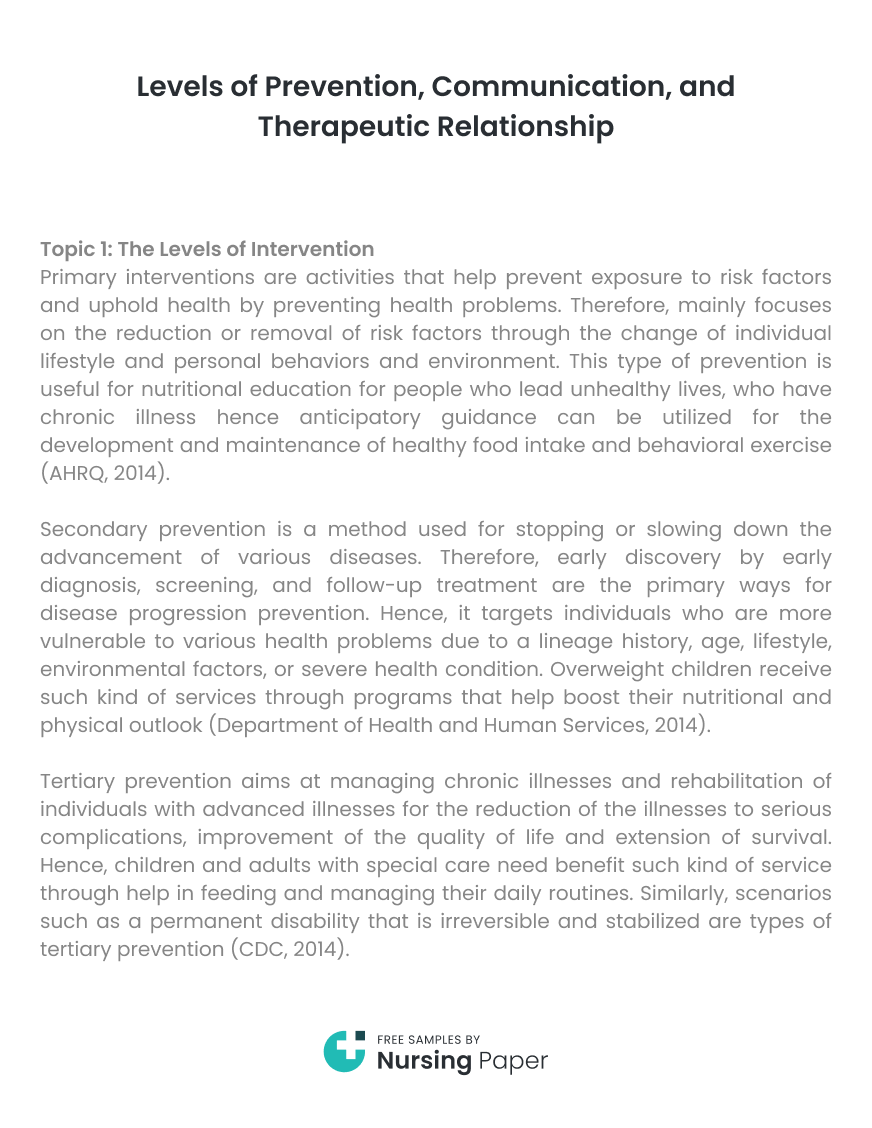
Levels of Prevention, Communication, and Therapeutic Relationship
Topic 1: The Levels of Intervention
Primary interventions are activities that help prevent exposure to risk factors and uphold health by preventing health problems. Therefore, mainly focuses on the reduction or removal of risk factors through the change of individual lifestyle and personal behaviors and environment. This type of prevention is useful for nutritional education for people who lead unhealthy lives, who have chronic illness hence anticipatory guidance can be utilized for the development and maintenance of healthy food intake and behavioral exercise (AHRQ, 2014).
Secondary prevention is a method used for stopping or slowing down the advancement of various diseases. Therefore, early discovery by early diagnosis, screening, and follow-up treatment are the primary ways for disease progression prevention. Hence, it targets individuals who are more vulnerable to various health problems due to a lineage history, age, lifestyle, environmental factors, or severe health condition. Overweight children receive such kind of services through programs that help boost their nutritional and physical outlook (Department of Health and Human Services, 2014).


Tertiary prevention aims at managing chronic illnesses and rehabilitation of individuals with advanced illnesses for the reduction of the illnesses to serious complications, improvement of the quality of life and extension of survival. Hence, children and adults with special care need benefit such kind of service through help in feeding and managing their daily routines. Similarly, scenarios such as a permanent disability that is irreversible and stabilized are types of tertiary prevention (CDC, 2014).
Topic 2: Communication and Establishing a Therapeutic Relationship
Response for individuals in value conflict
Withholding criticisms by accepting and respecting the fact that each has different values helps reduces chances of conflict. Explaining to the other person that people have different values is important as it paves the way for peaceful negotiation and relation. Applying rational and cognitive control process is needed for addressing the conflict. Slowing down in response minimizes the chances of conflict escalation (Knox & Haupt, 2015).
Methods of Communication
Such communications need the bridging and recognizing cultural differences of different individuals and are important because it increases communication effectiveness. Engaging in healthy conversation in a respectable and understandable manner reduces the chances of conflict progression. However, sharing different experiences and perceptions help ease communication problems in conflict of values. Cognitive aspect of communication allows good brainstorming of differences reduces opportunities of verbal exchange (CDC, 2015).

Aspects of the Communication Process Used To Overcome Any Potential Barrier
The use of cognitive communication process helps overcome potential obstacles to prevent the creation of communication misunderstandings, and it is essential to offer a broad knowledge of the reasons why values differ in individuals. It provides a person with the ability to navigate through the solutions and response provided for prevention of potential barriers. The respect for different values reduces the chances of conflict. Similarly, individual and cultural barriers may arise, but through a shared understanding of cultural and health beliefs, there is the realization of quality life (Guide to Clinical Preventive Services, 2014).
Conclusion
Discussion of patient perspectives provides an effective and sustainable outcome. Proposing a follow up to assess the progress of conflict in the perception of nurses help patients relate well and ease communication about issues that have different perspectives. The cost for lack of improvements exposes adults to greater challenges in the society and lack of rational decision concerning health present poor clinical outcomes.
1. Agency for Healthcare Research and Quality (AHRQ). (2014). Guide to clinical preventive services. Retrieved from https://www.ahrq.gov/professionals/clinicians-providers/guidelines-recommendations/guide/index.html
2. Centers for Disease Control and Prevention (CDC). (2014). Principles of epidemiology in public health practice. An Introduction to applied epidemiology and biostatistics (3rd Ed.). Retrieved from https://www.cdc.gov/ophss/csels/dsepd/ss1978/ss1978.pdf
3. Centers for Disease control and Prevention (CDC). (2015). Tools for cross cultural communication and language access can help organizations address health literacy and improve communication effectiveness. Retrieved from https://www.cdc.gov/healthliteracy/culture.html
4. Department of Health and Human Services. (2014). Leading Health Indicators. Retrieved from http://healthypeople.gov/2020/LHI/default.aspx
5. Guide to Clinical Preventive Services. (2014). Recommendations of the US Preventive Task Force. Retrieved from https://archive.ahrq.gov/professionals/clinicians-providers/guidelines-recommendations/guide2012/guide-clinical-preventive-services.pdf
6. Knox, C. C., & Haupt, B. (2015). Incorporating cultural competency skills in emergency management education. Disaster Prevention & Management, 24(5), 619.



The download will start shortly.

The download will start shortly.
 Subject:
Nursing
Subject:
Nursing  Number of pages: 2
Number of pages: 2  Subject:
Nursing
Subject:
Nursing  Number of pages: 2
Number of pages: 2  Subject:
Medicine
Subject:
Medicine  Number of pages: 3
Number of pages: 3  Subject:
Health and Social Care
Subject:
Health and Social Care  Number of pages: 3
Number of pages: 3  Subject:
Health and Social Care
Subject:
Health and Social Care  Number of pages: 3
Number of pages: 3  Subject:
Nursing
Subject:
Nursing  Number of pages: 6
Number of pages: 6  Subject:
Medicine
Subject:
Medicine  Number of pages: 14
Number of pages: 14  Subject:
Nursing
Subject:
Nursing  Number of pages: 2
Number of pages: 2  Subject:
Medicine
Subject:
Medicine  Number of pages: 5
Number of pages: 5  Subject:
Health and Social Care
Subject:
Health and Social Care  Number of pages: 5
Number of pages: 5  Subject:
Nursing
Subject:
Nursing  Number of pages: 5
Number of pages: 5  Subject:
Health and Social Care
Subject:
Health and Social Care  Number of pages: 8
Number of pages: 8  Subject:
Nursing
Subject:
Nursing  Number of pages: 3
Number of pages: 3  Subject:
Health and Social Care
Subject:
Health and Social Care  Number of pages: 20
Number of pages: 20  Subject:
Medicine
Subject:
Medicine  Number of pages: 7
Number of pages: 7 
